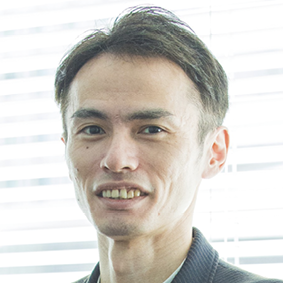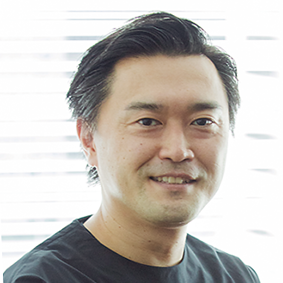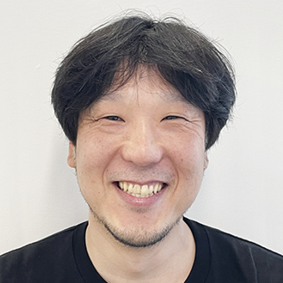COVER STORY:ACTIVITIES 3
Partnership between GlobalLogic and Lumada Innovation Hub Tokyo
GlobalLogic Japan was established in April 2022. The work of the company is to investigate and implement team structure and processes that will enable customers in Japan to accelerate their digital businesses and pursue DX successfully. This article describes the team structure and processes that combine the innovative knowledge and methodologies of GlobalLogic, a leader in design-led digital engineering, with the extensive business track record of Hitachi, Ltd., and the business understanding and experience that the DX specialists at Lumada Innovation Hub Tokyo have in working with customers in Japan.



GlobalLogic Japan, Ltd. (GL Japan) was established in April 2022 to play a leading role in design-led digital engineering for customers in the Japanese market(1).
GL Japan has office at the Lumada Innovation Hub Tokyo (LIHT). It works on digital transformation (DX) for customers in Japan and seeks to achieve a synthesis by bringing specialists from a variety of fields together at LIHT, including sales, engineer, designer, architect, and program manager from GlobalLogic and Hitachi.
GL Japan is working on an organizational system that combines GlobalLogic’s innovative knowledge and methodologies (GL-Way), with the business understanding and experience of the DX specialists at LIHT in working with customers in Japan. The way this works is called “two in the box,” whereby DX specialists from GlobalLogic and LIHT are paired in core roles in both the pre-sales activity and delivery phases, respectively. The division of roles between them is worked out at the same time as investigating how to undertake the project in a way that suits the Japanese market. This involves GlobalLogic’s specialists delivering services leveraging GL-Way while LIHT’s DX specialists provide support by utilizing their understanding and experience with customers in Japan.
Figure 1 | Specialists from GlobalLogic and Hitachi, Ltd. Engaging in Co-creation at LIHT  Customers, partners, and a range of specialists from GlobalLogic and Hitachi combine the virtual and the real to support customer DX.
Customers, partners, and a range of specialists from GlobalLogic and Hitachi combine the virtual and the real to support customer DX.
Figure 2 | How Collaboration Works in Pre-sales Activity and Delivery Phases  GlobalLogic is a leading company in the global DX business. To accelerate the digital business activities of customers in Japan, it applies its innovative knowledge and methodologies (GL-Way) to the Japanese market in tandem with customer support that draws on Hitachi’s extensive business experience.
GlobalLogic is a leading company in the global DX business. To accelerate the digital business activities of customers in Japan, it applies its innovative knowledge and methodologies (GL-Way) to the Japanese market in tandem with customer support that draws on Hitachi’s extensive business experience.
Taking note of the nature of the issues raised in pre-sales activities with customers, GL Japan brings together its experience and past work on design, engineering, and data science to provide end-to-end (E2E) support for the customer’s digital journey, extending from experience-centric design and engineering that draws on the latest technologies to maintenance and enhancement.
In practice, this equates to two service offerings in particular: an advisory phase on identifying the DX services that end users are really looking for, and a digital engineering phase for implementing the cutting-edge technologies required for the proposed DX service. GL Japan can also provide engineering labs, enabling a flexible and agile response to market conditions and changes in customer strategies and tactics by providing comprehensive support across all steps in the digital journey, not just at specific phases such as the advisory and digital engineering phases. For example, support can be provided as an ongoing accompanied service whereby GlobalLogic staff with the required design and engineering skills work with the corporate customer on an in-house basis, serving as their DX research and development (R&D) team.
Figure 3 | Service Offerings to Help Customers Accomplish their DX and Digital Journey  By partnering with customers engaged in DX, GL Japan provides service offerings that extend from the use of design thinking for market analysis and strategy formulation to development planning and the ultimate creation of a working product.
By partnering with customers engaged in DX, GL Japan provides service offerings that extend from the use of design thinking for market analysis and strategy formulation to development planning and the ultimate creation of a working product.
Figure 4 | GL Japan Advisory Stages  The advisory process can be broadly divided into four stages, starting with an exploration of business directions, followed by analyses of the market and target customers, the formulation of strategies for developing the best products or services, and detailed development planning. The process starts from the stage that best suits the customer’s current circumstances.
The advisory process can be broadly divided into four stages, starting with an exploration of business directions, followed by analyses of the market and target customers, the formulation of strategies for developing the best products or services, and detailed development planning. The process starts from the stage that best suits the customer’s current circumstances.
One example in which GlobalLogic and Hitachi are bringing their different strengths to the provision of services to a customer in the Japanese market is a co-creation project with Nojima Corporation(2). With the aim of improving the in-store user experience and having retail staff focus on consulting with individual customers about which products best fit their needs, Nojima is working with GL Japan to investigate how digital technology can be used in the retail environment. This includes a proof-of-concept (PoC) trial to test and verify these measures in an actual store.
The project follows the “two in the box” approach, with the strategists being design strategists from LIHT and METHOD, the strategic design arm of GlobalLogic. The designers are experience designers, also from LIHT and METHOD.
As the user experience when purchasing home appliances in Japan is very different than that in North America, the way that Nojima deals with customers was likewise unfamiliar to METHOD. Accordingly, they embarked on the joint work by having the Japanese team members use story-telling to demonstrate to their colleagues from METHOD the practices that Nojima values so highly for dealing with customers, drawing examples from their own user experiences of being served at a Nojima store.
Before starting on a DX project with a customer, GL Japan conducts workshops where they listen carefully to the customer’s concerns and determine what it is that DX needs to achieve. In consultations with Nojima, they talked about three considerations in particular that they wanted DX to address. In the course of these discussions, GL Japan determined at what stage their advisory services should begin, deciding to start with a “Stage 2 Desirability Led” approach involving research and analysis, including in-store observations and interviews.
These in-store observations and interviews also used the “two in the box” approach. The project conducted observations at four Nojima stores and held interviews with 10 Nojima staff. In addition to providing language assistance to the METHOD designers, such as explaining the advertising stickers on products, the Japanese team members also helped speed up their learning by contributing knowledge about home appliance use in Japan and the features of the stores and their neighborhoods. The METHOD staff in turn drew on their unfamiliarity with Japanese practices to identify things that looked out of place and to provide essential insights.
Based on an analysis of these observations and interviews, they came up with 20 ideas for how the in-store user experience could be enhanced. A workshop was held a week after the completion of the study to present the results of analysis and discuss the improvement ideas. Two weeks after that, the ideas identified during the discussion as representing the highest priority concepts were presented to Hiroshi Nojima, Representative Executive Officer and President of Nojima Corporation. During this time, the architects worked with the strategists and designers to provide feedback on how feasible their ideas were from a technical standpoint.
This filtering of ideas through the consideration of user needs, business viability, and technical feasibility is a key feature of how GL Japan is able to focus in quickly on proposals that the customer will be able to implement. The result was a positive decision from Nojima management to proceed with a PoC trial. As of December 2022, this project is still running and trials of in-store digital initiatives are already underway.
The respective strengths of GlobalLogic and Hitachi encompass personnel, experience, and business footprint. What GL Japan has to offer is the ability to undertake projects by combining these in ways that fit with what is needed to resolve the challenges that customers face in the Japanese market. Such projects aimed at achieving DX are already underway for customers from a variety of industries in the Japanese market, including the finance area.
Figure 5 | In-store Survey and Idea Review Workshop  For the in-store survey, staff from METHOD and specialists from LIHT explore potential ideas for DX innovation by gaining a deeper understanding of the stores. Similarly, idea review workshops utilize rough drafts of the ideas being considered by GL Japan to discuss and prioritize them.
For the in-store survey, staff from METHOD and specialists from LIHT explore potential ideas for DX innovation by gaining a deeper understanding of the stores. Similarly, idea review workshops utilize rough drafts of the ideas being considered by GL Japan to discuss and prioritize them.
As the different parts of Hitachi come together to accelerate DX in the Japanese market and resolve societal challenges, the DX specialists from GlobalLogic and LIHT have been using project work to combine their resources under Lumada.
In the future, the intention is to use case studies and other means to spread knowledge across Hitachi, engaging in co-creation in ways that best suit customers and promoting DX in the Japanese market.
The co-creation with Nojima Corporation described in this article received considerable assistance, including the arrangement of store visits and workshops. Valuable support was also received from the retail staff and other people involved, not the least of which was Hiroshi Nojima, Representative Executive Officer and President of Nojima Corporation. The authors would like to take this opportunity to express their deepest gratitude.